Standard and characteristics of the German Shepherd. German Shepherd: RKF Breed Standard
If you decide to connect your life with a purebred German, then you just need to read and study this article. Today we will look at the standard german shepherd, adopted and approved by the RKF (Russian Cynological Federation).
Your choice is quite understandable, because it is difficult to find a more devoted friend and partner. This dog is courageous, extremely energetic, cheerful and versatile. Still, it’s not enough to want to take a puppy home. Much needs to be known useful information which will help in . It is worth noting that dog breeds are constantly being modernized, so the standard cannot designate one formed one. Variations and changes are recorded from time to time. The main properties and norms of the breed are described in detail, specifying its appearance, highlighting subtle differences and specific traits belonging to this particular dog.
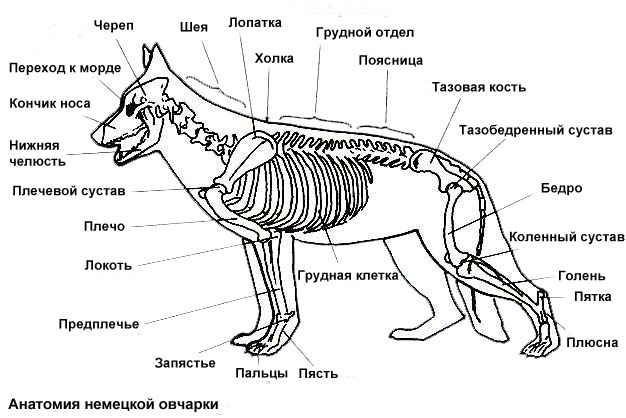
This emotional dog is very obedient, easily adapts to any environment, shows indifference to the owner's commands, fulfilling them with joy. Attacks only on the orders of the owner, while the rest of the time it remains calm and attentive, friendly to the unchanged environment,. Demonstrates courage, shows caution to outsiders "outsiders". Possesses courage, determination and confidence. Caring, submissive, loyal - these qualities make this dog breed a worthy friend, mostly invaluable for protection.
The standard German Shepherd evokes a sense of primal power. Subtle mind, animal flexibility express purebred predisposition. It is about such animals that they say: "A healthy mind is in a healthy body."
Based on all this, a standard has been adopted, which implies the physical and psychological properties of the breed. It expresses the external characteristic features of the dog. Quality improvements have emphasized the correct anatomical structure, the distinguishing features of which are a healthy disposition and a beautiful nature.
Only experts with great practice can determine the susceptibility of the German Shepherd to the regime and service. They also check the certification of dogs for mental state and physical fitness.
All kinds of faults affect the breed standard. Lack of it or excess leads to various deviations. Such as cowardice, excessive excitability, apathy, nervousness, low efficiency. Incorrect body constitution, small testicles, defect in posture, lack of pigment - albinos, underdevelopment of physique, defects in endurance of the musculoskeletal system, etc.
Now let's look at all this in more detail.
Refined appearance, discipline, vigor, accuracy are exemplary features of the breed. Breeding dog with excellent sense of smell and absolute hearing aid, stable central nervous system. Athletic and large build slightly stretched, above average size.
The ratio of growth and length is 9:10, respectively, the growth is less than the length by about 10%.

Average height fixed by the standard:
- For males - 63 cm;
- For bitches - 56 cm.
Possible deviation of 2 centimeters. Changes in different sides from average height significantly reduce the dignity of the pet.
The constitution of the body guarantees the feasibility of a long run, protects the coat from natural weather influences.
Sexual characteristics in cables and bitches are extremely pronounced. Pronounced, developed two testes at the cables are located in the scrotum.
Now consider the exterior of the German Shepherd, those prevailing characteristics, the safety of which is necessary when breeding breeding breeds.
Musculoskeletal system
The spine is the basis of the body, the rest of the proportion of the dog depends on its ratio.
With an exact correspondence of length and symmetry to height, the bones form an excellent motor system. There is a feeling of movement, devoid of tension. When serenely running, the dog's limbs move in a diagonal progression, forming a solid line from the end of the tail to the end of the ears.
Heights are combined as follows: the front legs move the same distance as the hind legs, approximately to the middle of the body. Any movement of the hind leg reduces stamina and strength.
limbs
the front of
Inspection from any side shows that the forelegs are straight, with rounded, strong pads with strong claws. When viewed from the front, you can see that the legs are parallel. On the long shoulder are even powerful shoulder blades and shoulder levers. The ideal angle between them is 90 degrees, 110 degrees is acceptable.
The length is slightly greater than the height, somewhere around 55-58%. The elbows are pressed to the chest and set straight back. When moving, or in a resting position, they cannot be twisted or shifted.
Proportionate, strong forearm forms a slope of 20-22 degrees. If the slope is less than 20 degrees, then this expresses a negative impact on durability and quality.
Faults: Extremely vertical forelegs are a fault.
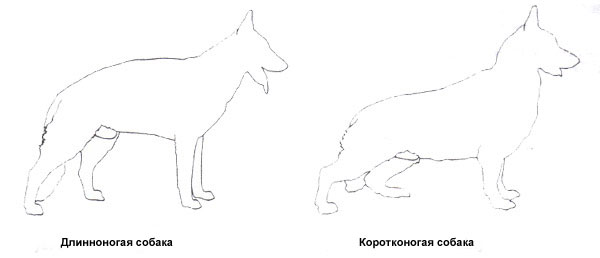
Rear part
Viewed from behind, the legs are straight and set slightly behind the line of the ischial tuberosities. Muscular, equal lower legs, connecting to the thigh, form a knee angle of 120 degrees. Well defined hocks are strong and carried low. On oval, compact paws, dark, strong pads with strong claws. V early age dewclaws are eliminated.
Disadvantages: A right angle of joints is considered a defect.
Frame
Considered a trotter, the German Shepherd has a slightly elongated build. Accordingly, the length of the body itself exceeds the height at the withers by 110-115%. Such a constitution of the body allows the German to move in a sufficiently careless and economical manner.
Tail
A well-furred, fluffy tail curls up and rises as it moves. Whereas in a calm state it hangs down, forming an arc, with a slight slope. Artificial intervention in the correction is categorically impossible.
Faults: The tail should not be extremely short and should not be twisted into a ring.
Neck
In a calm state, a strong, muscular neck is at an angle of 45 degrees relative to the body, has no skin folds. When excited, the dog holds the neck high, while when trotting, it is at the level of the back, forming a straight line.
Disadvantages: The disadvantages include too long or vice versa, a short neck, the presence of folds on the skin.
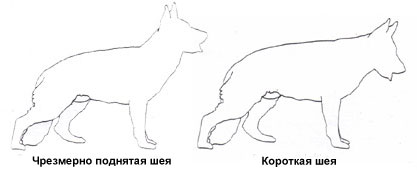
Breast
Restrainedly broad, deep chest forms an angle of 48 degrees from the height at the withers. The developed lower part is sharply defined and oblong. The ribs reaching the sternum are at the level of the elbows, attached to the spine with strong muscles.
Disadvantages: Breast defects such as too large or vice versa - small in size; hollowness, can lead to displacement of the elbow joints.
Small of the back
Since the chest is far behind, the loin is comparatively short. At the same time, it is extremely developed and wide.
Disadvantages: Deviations from the norm - too long loin.
Stomach
Restrainedly pulled up.
Disadvantages: A defect is considered to be too tucked up, lowered or straight belly.
Back
A strong and straight back has well-developed muscles. At the same time, the gap between the withers and the croup is small.
Faults: The fault is defined in a too narrow back. Also defects are a humpbacked and arched back.
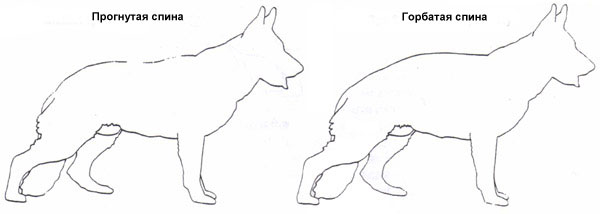
Croup
The long croup, flowing smoothly into the base of the tail, falls slightly to the topline at an angle of 23 degrees. The bone base is created by the sacrum and the hip bone.
Faults: Short, horizontal or sloping croup is unsuitable.
Withers
Unlike the back, the withers are well defined. A smooth translation of a sufficiently long and high withers to the back forms a slight slope.
Hips
Bulky hips have a strong muscle group.
Color
After changing the coat, you can determine the final color of breeding puppies. With the obligatory black color of the nose, the following main and very common colors are fixed: zone gray, black-black, black. About 90% of dogs have exactly black-backed color. The saturation of this color changes: from black to red.
Faults: Too light inner surface, white markings on the chest are a defect. The red tip of the tail is also considered unacceptable.
Wool
To the touch, the coarse hair on the head is shorter and softer than on the legs, toes, neck and on the back of the ears. On the hips, it forms a semblance of pants.
- normal coat;
- long-wire-haired breeding dog;
- long haired sheepdog.
Faults: Too thick hair of great length is considered a fault. Especially on the tail.
Head
The not very massive wedge-shaped head is in harmony with the size of the body, accounting for 40% of the height of the breeding dog.
Top part
This part of the head, which makes up 50% of the total length, when viewed from above, equally narrows towards the nose and has the shape of a wedge.
Faults: An out of proportion head is a defect.
Forehead
Slightly convex when viewed from the side, the forehead has a slightly pronounced furrow in the middle.
cheekbones
The cheekbones that do not protrude forward are rounded from the side.
Lips
Thin dense lips should be dry to the touch.
Jaw
A healthy jaw should have full set strong teeth - 42 pcs. (22 in the bottom row, 20 in the top). A scissor bite is required, in this form the upper incisors cover the lower. The replacement of dairy (28 pcs.) For indigenous takes place within five months.
Disadvantages: The defect is a yellow plaque and broken teeth worn out of age, which interfere with the correct bite. A light lower jaw indicates a deviation from desired type physique.
Ears
The high-set ears, wide at the base, are of medium size. They are directed by the shell forward, have a pointed appearance. Although puppies of this breed are up to six months old, during the replacement of teeth, they can hang, pointing inward. In an excited or recumbent state, a pedigree dog may press its ears. This is not considered a violation.
Faults: Semi-erect ears hanging on soft cartilage.
Eyes
Asymmetrically set, almond-shaped eyes are of medium size. Their tone matches the color of the coat, presumably dark. The intelligent expression of the eyes is slightly expectant.
Faults: Deep-set bug-eyed eyes that are too light in color.
Conclusion
A noble and well-coordinated German Shepherd must have absolutely all the pronounced properties of its magnificent breed.
Any offshoot from the standard indicates a lesser breeding conformity of the dog.
Now consider the individual parts of the body of a German shepherd.
head of german shepherd
Head wedge-shaped, of appropriate size (length approximately 40% of the height at the withers), should not be coarse or unduly light.
The general impression is dry, moderately wide between the ears. The forehead, when viewed from the front and from the side, is only slightly convex, without a frontal groove or with a very weak expression of it. The skull to muzzle ratio is 50% to 50%. The width of the skull roughly corresponds to its length. The skull (when viewed from above), tapering evenly from the ears to the nose, with a noticeable but not pronounced transition from the forehead to the muzzle, passes into a wedge-shaped muzzle. The upper and lower jaws are strongly developed. The back of the nose is straight, deflection or hump is undesirable (but not a defect). Lips dry, close-fitting, dark in color.
Nose. Must be black.
Eyes of medium size, almond-shaped, set in a slightly oblique section, not protruding. Eye color should be as dark as possible. bright eyes with
piercing eyes are undesirable, as it breaks the expression of the dog.
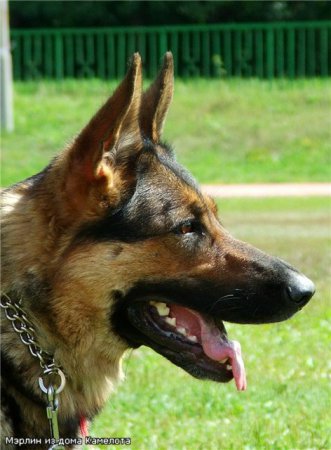
Of great importance when evaluating a German Shepherd is the “expression” characteristic of the breed, which is difficult to describe, but invariably
catches the eye when it is.
This is a combination of exact proportions, “purity” of profile lines, head color, shape and color of the eyes, set of ears and, of course, the impression of strength, nobility, and at the same time, a lively expression of intelligence and self-confidence. All this together creates a picture of the expression inherent in the breed
German Shepherd. In addition to the above, it is worth saying that most often correct form head is in close relationship with the general breed of the dog.
To date, the breed is dominated by dogs with the correct head shape, but in some lines there are still problems with the structure of the lower jaw, which, according to the standard, should be well developed and fairly wide. Neglect of this requirement at exhibitions and selections leads to the appearance of German Shepherds with a weak lower jaw, physically unable to pass the training standards due to a weak grip, and in some cases even leads to malocclusion.
german shepherd teeth
![]()
Must be strong and healthy; full dental formula (symbolic record, using numbers and letters, which shows the location, number and type of teeth in the dog's mouth) (42 teeth in accordance with the dental formula.
There may be several types of recording of the dental formula, for example, where the numbers in front of the letter indicate the number of teeth of a certain type, and the letters indicate the type of teeth.
The permanent teeth formula is as follows:
2M 4P 1C 3I 3I 1C 4P 2M (upper jaw) -20 teeth
3M 4P 1C 3I 3I 1C 4P 3M (lower jaw) - 22 teeth
or, where the numbers after the letter indicate the place of the given tooth, and the letter indicates the type of tooth:
M2,M1,P4,P3,P2,P1,I3,I2,I1 I1,I2,I3,C,P1,P2,P3,P4,M1,M2
M3,M2,M1,P4,P3,P2,P1,I3,I2,I1 I1,I2,I3,C,P1,P2,P3,P4,M1,M2,M3
dental system
Upper jaw:
3 cutters (Incisivi)
1 fang (Caninus)
4 premolars (Praemolares)
2 molars (Molares)
Lower jaw:
3 cutters (Incisivi)
1 fang (Caninus)
4 premolars (Praemolares)
3 indigenous (Molares) - molars.
The German Shepherd has a scissor bite, i.e. the incisors should fit together like scissors so that the incisors of the upper jaw overlap the incisors of the lower jaw in a scissor-like manner. A level bite, undershot bite, or undershot bite are faults, as are large gaps between teeth (gaps). Equally incorrect is the non-linear arrangement of the incisors. The jaw bones must be strongly developed so that the teeth are firmly inserted into the alveoli.
On this point of the standard, comments, it seems to me, are superfluous.
In the modern population of German Shepherds, the percentage of births of puppies with dental problems is relatively low and does not pose a threat to breeding. I would like only to dwell on the discrepancy between the provisions on exhibitions in the FCI and SV systems, regarding
acquired deficiencies of the dental system. If, according to the SV regulation, at specialized breed shows, with supporting documents, dogs with missing teeth can be shown, which is a consequence of an injury, and this does not affect the assessment, then there is no such provision at FCI shows. Taking into account the specifics of the breed, which implies increased traumatism during training (apporting, overcoming barriers, protection work, etc.), this situation seems justified.
german shepherd ears
The German Shepherd has medium-sized, erect ears that are held vertically and point parallel (do not converge inwards). They taper towards the ends, and the auricles are open forward. Semi-erect or hanging ears are a defect. Ears laid back in motion or at rest are not a fault.
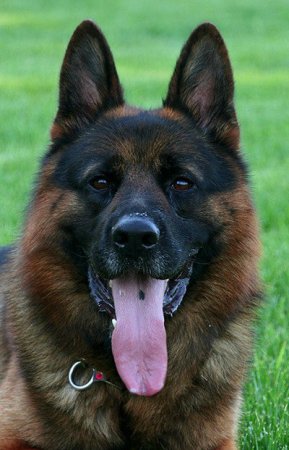
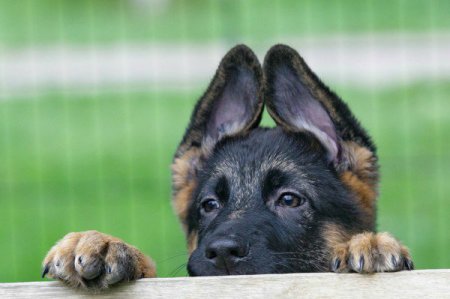
V last years the problem of setting the ears in a German shepherd is becoming bigger problem. Apparently, this is due to the constitutional changes taking place in the breed. The more large, heavy dogs appear, the more often we are faced with a situation where the ears of puppies rise late and hard, which, moreover, often have an excessive size, thin and weak cartilage. trying different ways to influence this process (gluing, etc.), breeders and owners drive this problem into a corner without solving it genetically. And no one is surprised by cases of incorrect set of ears in adult dogs. Sometimes the ears do not rise at all, despite the titanic efforts of the owners, and this is a serious reason for the breeders of such dogs to think.
The Standard prescribes an approximate elevation of the ears in puppies on average between the ages of 3 and 6 months, with the ears being fully erect at 6 months. The ears of a German Shepherd puppy may begin to rise at 2 months of age. age, there are also earlier cases, on this occasion the opinion about the violation of mineral metabolism is so widespread - this is not always the case. With proper care and cultivation, this often occurs in dogs of working breeding.
Just as often, the ears of a puppy, having risen at 3 months, may fall a little later, or periodically rise and then collapse again. This phenomenon is absolutely acceptable and is due to the fact that the period of changing teeth (deciduous to permanent) lasts from about 3 to 6 months. and, accordingly, is superimposed on the period of formation of the auricles, in addition, the period (peak) of the most intensive growth of the puppy is superimposed.
Examples of incorrect set of auricles in an adult German Shepherd
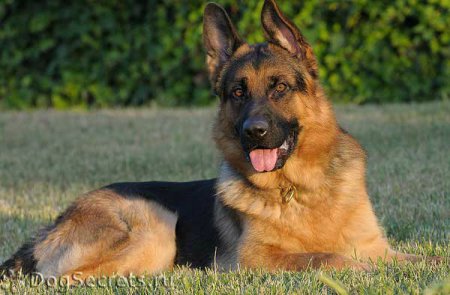

From myself I would like to add that the ear consists of one of the types of connective tissue - cartilage, which in turn consists of chondrocyte cells. A building material for cartilage are chondroitin and glucosamine. Now there are many mineral supplements containing these substances that must be used during the growth and development of the puppy. Note the simplest and most reliable source of glucosamine, chondroitin and collagen is table gelatin.
Frame
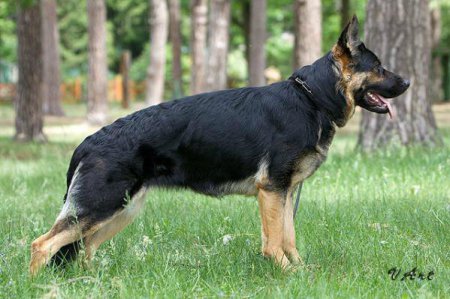

The topline is solid, extending from the base of the neck, through a well-defined withers and back, set very slightly in an oblique position towards the horizon, gradually passing over a sloping croup. The back is strong, strong, muscular. The loin is short, well developed and muscular. The croup should be long, slightly sloping (about 23 degrees to the horizontal) and blend inconspicuously with the root of the tail. Not humpbacked, not sagging.
Dog with irregular topline
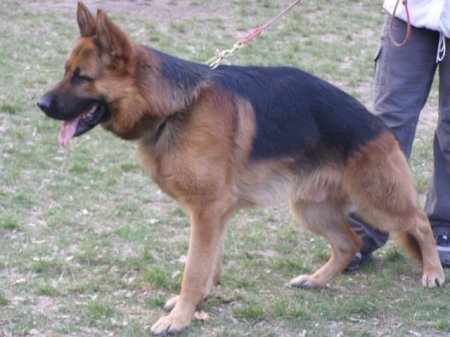
Breast
"Moderately broad, brisket as long as possible, lower chest well developed. Depth of chest (from withers to elbow perpendicular to the ground) should be 45-48% of the height at the withers. Barrel-shaped or too flat ribs are a fault."
German Shepherd- a working dog, therefore for it the structure of the body is one of the main breed characteristics, on which its working performance directly depends. The body serves to fasten the animal's motor apparatus, to transfer the impulse that occurs when the hind limbs push to the front part of the body, to maintain balance during movement. And, of course, all vital organs and tissues are located in the chest, which is part of the dog's body system.
In a properly built German Shepherd, the body should give the impression of integrity and completeness. The topline, formed by the spine, should be a straight line, as if drawn by a single stroke of the pen, smoothly falling from a well-defined withers to the root of the tail. An extremely important role is played by the horizontal proportions of the body, i.e. the optimal ratio of the thoracic (50%), lumbar (25%) and sacral (25%) sections of the spine, ensuring the harmony and strength of the German Shepherd and the balance of its movements.
Returning to the conversation about the stretched body, which is defined by the breed standard, we should dwell on the concept of compactness, which is sometimes confused with the concept of short format. Paradoxical as it may seem at first glance, the German Shepherd must have a compact body with a general elongated format.
It should be noted that most of the modern German Shepherd population does not have significant problems in the structure of the body. The only exception is, perhaps, the length of the croup, which leaves much to be desired in a significant part of
livestock. Sometimes there are dogs with a shortened chest and a stretched loin.
Good shepherd chest of the correct depth.
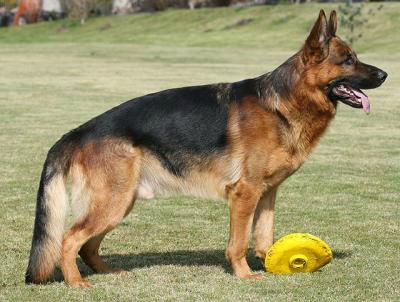
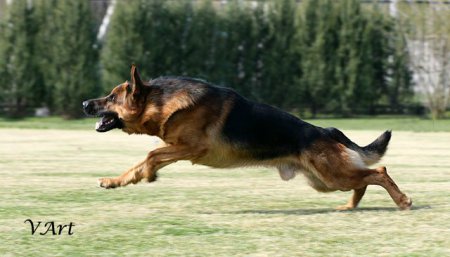
Flat rib dog

Tail
Reaches at least to the hock, however, no further than the middle of the metatarsus. On its underside, the hair is slightly longer, the tail
held hanging in a soft curve. When the dog is excited or in motion, the tail is lifted and carried above but not above the horizontal line (dog's topline). Surgical correction of the tail is prohibited."
In addition to the fact that the tail of a dog is an important breed feature and acts as a kind of balancer that facilitates body control during movement and turns, it also serves as an indicator of the health of the animal to some extent.
The German Shepherd has a problem that many breeders overlook, partly due to ignorance, partly due to the fact that this defect in adult dogs is hidden behind a rich coat on the tail. It's about about the so-called "crease" of the tail - a genetically determined pathology of the caudal spine, manifested in a change in shape, varying degrees thickening and improper fusion of individual tail vertebrae. Unfortunately, the standard of the German Shepherd does not say anything about this, but according to the latest scientific data, this pathology in dogs is genetically associated with impaired psychomotor functions, changes in other parts of the spine and, possibly, even the spinal cord.
The correct set and the correct shape of the tail of a German shepherd

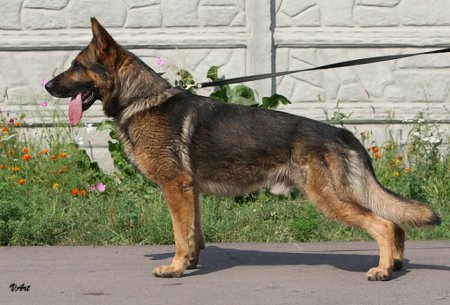
Incorrect set and tail shape in a German shepherd

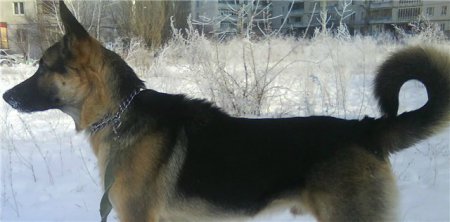

FOREQUARTERS
When viewed from all sides, the forelegs are straight and when viewed from the front are absolutely parallel. The shoulder blades and shoulder levers are equal in length, muscular and firmly attached to the body. The angle between the shoulder blade and the humerus is ideally 90 degrees, but up to 110 degrees is acceptable. Elbows should not be turned in or turned out, neither at rest nor in motion. Seen from all sides, the forearms are straight and absolutely parallel to each other, lean and muscular. The pastern is approximately 1/3 the length of the forearm, and is located in relation to it at an angle of 20-22 degrees. Weak pasterns (at an angle of more than 22 degrees) or steep (at an angle of less than 20 degrees) affect the working fitness of the dog, especially its endurance. The forelegs are rounded, tight, with arched toes, pads strong, not cracked; strong claws, dark color".
The forelimbs serve to support the body and cushion the body during movement. They take on the entire weight of the body in contact with the ground, and the load on them is greater, the faster the dog moves. In a properly built German Shepherd, the forelimbs carry only the supporting
function without taking part in the push. They do not have a bone attachment to the body, this connection is carried out with the help of muscles, therefore the front part of the body must be equipped with well-developed, relief muscles and elastic, elastic ligaments.
The scapula plays a key role in the distribution of balance during movement. Its length, width and sloping position (45° to the horizon line) provide a characteristic high front for the breed (when it seems that the rear part of the body is crouched, this is due to the high front). The humerus should also be long, equal in length to the shoulder blade, and ensure that the forelimbs are set strictly under the withers. The preservation of high forwardness and the length of the step of the forelimbs also depend on its length.
Strength, parallel set and straightness of movement of the limbs in German terminology was called "korrekte Front" (correct front).
In German Shepherd breeding, the shoulder girdle has always been the weakest link. To this day, obtaining animals with an ideal structure of the humeroscapular joint is considered a great success for breeders. The most common problems are insufficient length and inclination of the scapula, and as a result, a more “open” angle between the scapula and the humerus, which limits the width of the stride of the forelimbs.
Movements of a German Shepherd with a normal structure of the limbs


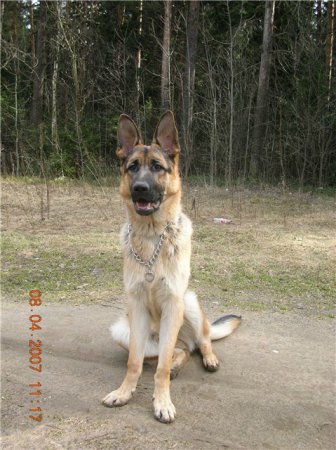
The hindquarters are set slightly apart; when viewed from behind, they are parallel to each other. Thigh and lower leg approx.
Equal length, strong and muscular and form an angle of about 120 degrees. The hocks are strong and stable. Metatarsus stand vertically under
hock joints. The hind feet are compact, slightly arched, the pads are hard and dark in color, the nails are strong and also dark in color.
The hind limbs also serve to support the body and mitigate concussion, but their main function is to push, performing which they act
like a power spring pushing the body forward. In this regard, they have thicker bones and more powerful muscles than the forelimbs. To maintain balance, they should be set a little wider than the front ones, since during movement in certain phases the forelimbs are between the hind legs. The narrow stance of the hind limbs hinders this action, moreover, it is associated with a narrow croup and, consequently, with insufficiently developed musculature of the rear part of the body. With the dog's natural stance, the hind limbs should be somewhat drawn back. A plumb line, lowered from the ischial tuberosity, crosses the lower leg of the leg set back in its lower third.
The femur is the most important lever in the mechanism of the hind limbs. The length of the step of the hind limbs depends on its length, on the width -
the possibility of developing muscles and the strength of the jerk function. Deficiencies in the structure of the thigh practically cannot be compensated for by anything and sharply devalue the dog, reducing the performance of its movements. The thigh and lower leg form the angle of the knee joint, from which the entire
movement process. The stifle angle should be well defined, rounded, and level with the elbow when the dog is free.
Mild stifle angulation usually occurs with a shortened femur, resulting in insufficient stride length.
In most modern representatives of the breed, the structure of the hind limbs is not satisfactory. But, there are individuals in which the hind limbs have an irregular structure, for example, close hocks, narrow set, clubfoot, etc. Sometimes some breeders do not pay attention to the problems of the hind limbs, while getting disabled dogs.
There is also a show trend, namely, an excessive passion for “corners”, which will inevitably affect the correctness and strength of the set of hind limbs. Weak metatarsus, contiguous hocks, and as a result - weakening of the spring functions when moving at a trot and loss of endurance are found in individual animals. Breeders and owners of shepherd dogs should pay attention to this.
Movement (trot) with strong hindquarters, correct set, with good angulations

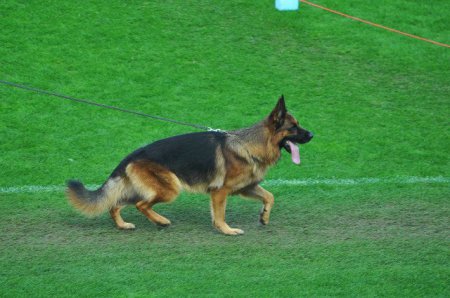
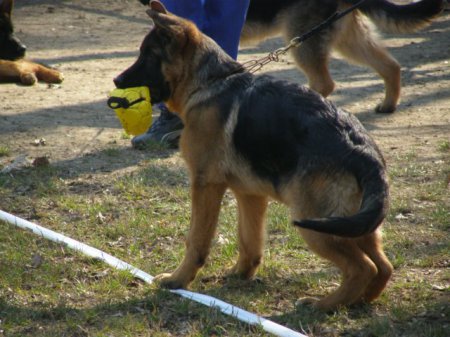
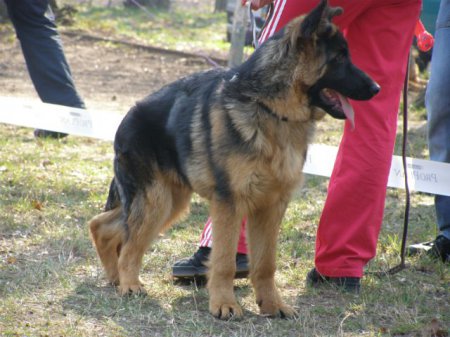
source forum RKS
Instruction
See how the puppies behave. They are already trying to fight for a place in the pack, so they often fight. It is not necessary to take the most aggressive one, it can be a lot of trouble with him on walks in crowded places. These dogs are more suitable for protection objects. You also need a friend who is not aggressive, but who can prove himself and stand up for defense at the right moment. Therefore, it is better to choose a puppy with an average balanced temperament. And don't even look at the cowards, shrill and tail-tucked.
The second important point is health. Pay attention to fatness, but if the tummy is excessively large, then this is one of the signs of helminth infection. Feel the coat, it should be soft, without a repulsive smell, without baldness and crusts. The eyes of a healthy puppy are clean and shiny. Nose - wet and cold, necessarily black without specks. Turn the puppy over and look at his belly. The presence of red dots, crusts indicates the presence of fleas or lice.
If you have a dog in front of you, then his testicles should descend into the scrotum by 3 months. Do not listen to the seller's assurances that this will happen later. Although, if you take a dog not for exhibitions, such a defect is not particularly important.
Stand the puppy and look at his paws. A good dog should have straight and strong limbs. No bending is allowed. This is a direct sign of malnutrition and rickets. But the joints can have nodularity; then, as the puppy grows, when the skeleton is formed and strengthened, this thickening will not be noticeable.
german shepherd dog has a slightly sloping croup, and in puppies this drooping is more pronounced. Do not be alarmed when the pet grows up, the slope of the croup will level off and return to normal.
See how the puppy you like is walking. If he puts his feet in one footprint, then this is normal if he throws his hind legs outward, this is a defect in the structure of the limbs. Look at the standing puppy from behind, if its metatarsus touches a little, then you should not refuse and choose another one, over time the croup will rise, and the setting of the hind legs will become correct.
Pay attention to the shape of the tail. If the puppy is calm, then his tail hangs, there may be a slight saber-like bend. In a state of excitement, the puppy raises the tail, but it should not be thrown high over the back, much less twisted into a ring.
And about color. Puppies are usually much darker than adults. dogs so take a look at that. A gray wolf color is also allowed, but it is not popular. See that there are no white marks on the chest and paws, although if you wish to make yourself a friend, it does not matter what colour he will?
Sheepdog is a great friend and a brave defender. You can get Scottish, Bernese or South Russian shepherd dog, owners, but most often the choice of future owners stops at a German shepherd. When buying a puppy, you must be sure that you are purchasing a purebred animal that fully meets the standards. Take the time to choose and compare and you will be rewarded with a healthy, cheerful and beautiful pet.
Instruction
Buy a dog only from a trusted breeder. You can get the address from others owners shepherd dogs Or at the dog club. The owner of the cattery guarantees not only compliance with the breed. A properly raised puppy will be less likely to get sick and develop properly. By the time of purchase, a thoroughbred puppy must be vaccinated.
Examine the litter. Experienced Owners dogs recommend to opt for the most active and curious puppy. young shepherd dog should not be afraid of sharp sounds, claps, strangers. The puppy's mobility and vigor means that he is healthy, will eat well, grow quickly and will not give you additional problems.
Take the puppy you like in your hands, examine it. Puppy shepherd dogs should be well-fed, have thick paws and a flexible tail. Do not take a too thin or, conversely, too fat animal with a swollen belly - this may indicate digestive problems or pathology of the internal organs.
Check the puppy's bite - it should be scissor. Incorrect bite guarantees disqualification at the exhibition, a ban on breeding breeding and nutritional problems. If you are buying a grown puppy, pay attention to his ears - by the age of six months they should be delivered.


